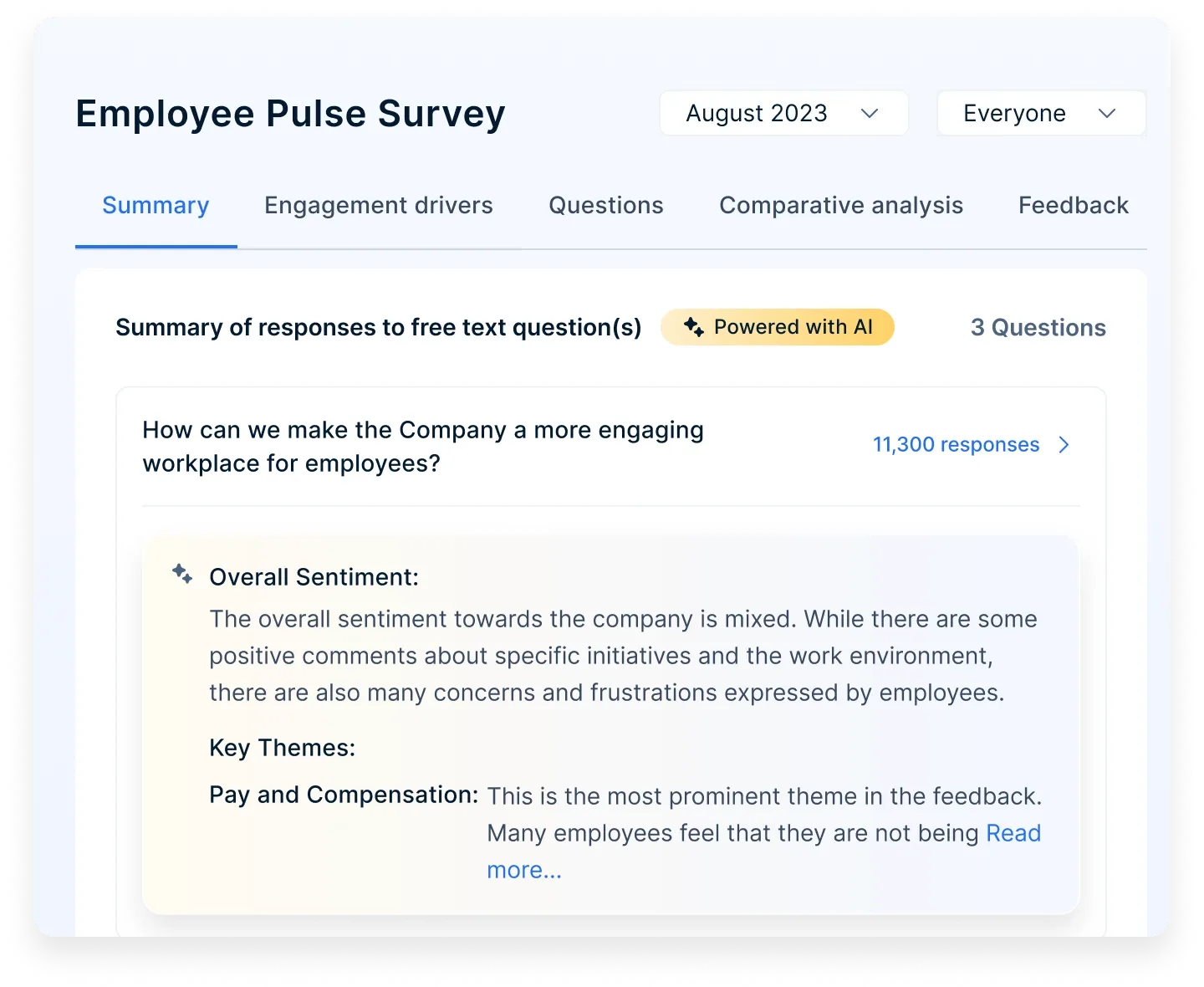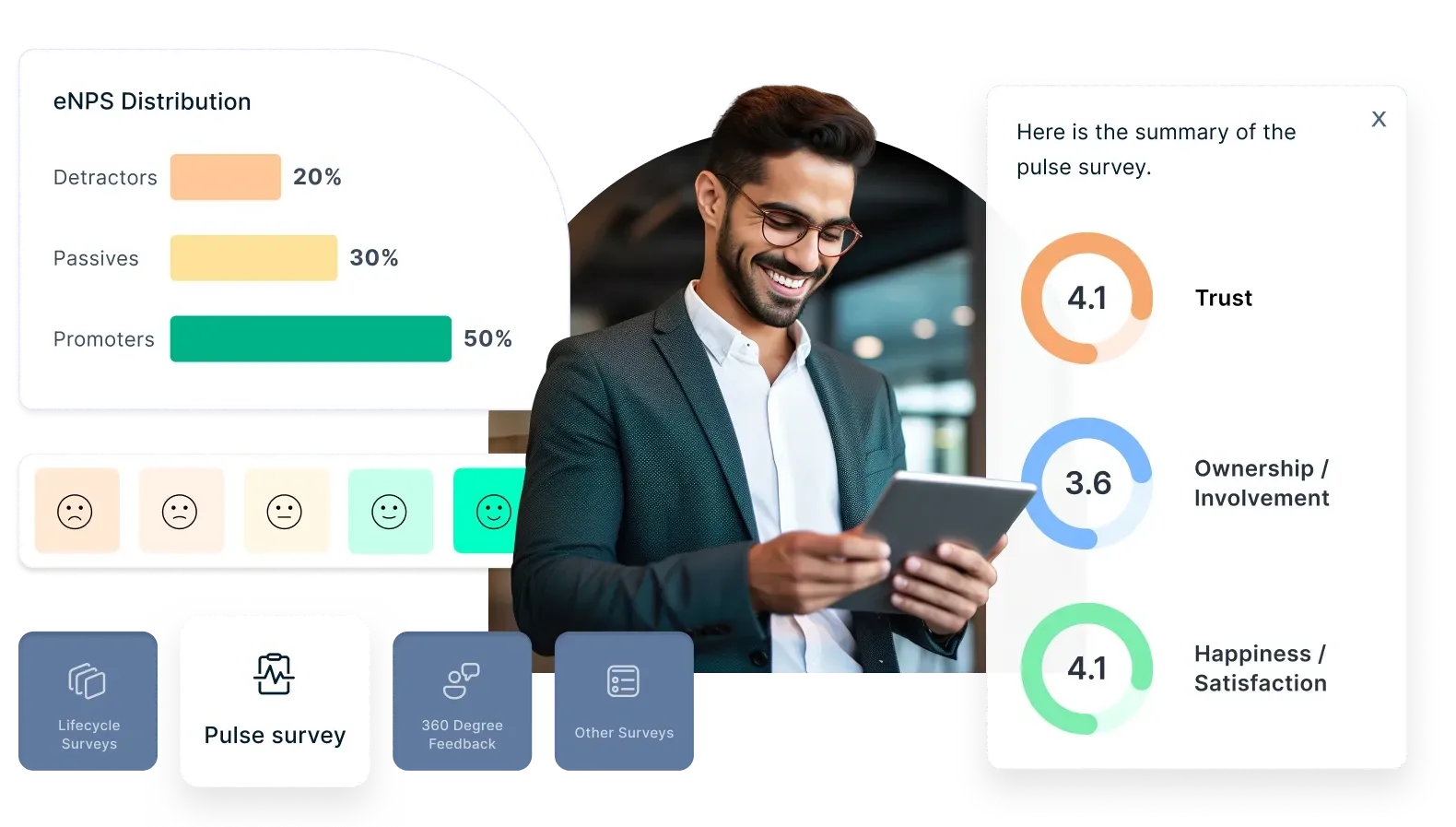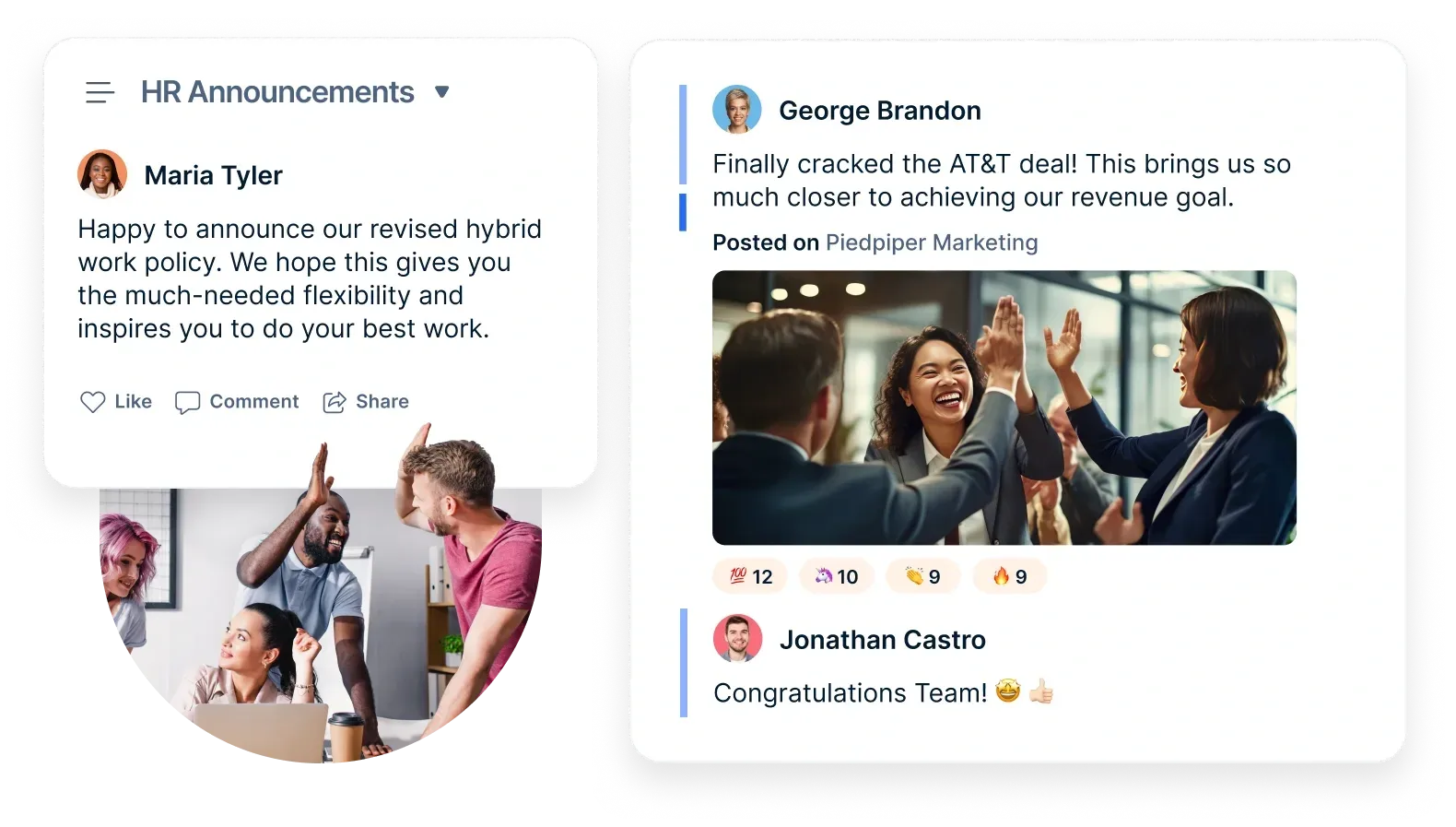15 Effective Employee Motivation Strategies for a Productive Workforce
Motivated employees drive business success but keeping them engaged requires the right approach. Explore employee motivation strategies and practical ways to improve motivation in the workplace, ensuring a productive and committed workforce.
On this page
Regardless of an organization’s size or industry, one of the biggest challenges for managers is ensuring their teams perform at their best. Employee motivation influences productivity, engagement, and overall business success.
Thinkers like Aristotle, Maslow, and Freud have long explored why people do what they do. In the workplace, motivation affects employee performance and retention. When motivation drops, productivity declines, and business growth slows.
A strong workplace culture supports motivation by addressing fundamental emotional drives. The drive to acquire is met through recognition and rewards. The drive to bond strengthens when communication and teamwork improve. The drive to comprehend grows when employees receive learning opportunities and challenging tasks. The drive to defend is supported by fair and transparent processes.
If you’re wondering how to improve motivation in the workplace, the answer lies in structured yet simple initiatives that build morale, engagement, and long-term success. In this blog, we’ll explore practical strategies to foster motivation and create a thriving workplace.
Proven strategies to improve employee motivation in the workplace
Keeping employees motivated requires more than just competitive salaries. A strong workplace culture, recognition, and growth opportunities all play a role.
Here are strategies to increase employee motivation that help create a more engaged and productive workforce.
1. Start before they join
Organizations need to have an engaging and strategic onboarding process for employees to keep them involved even before they join.
Such an onboarding process will also help in aligning the employee’s objectives with the organization’s objectives and vision. This motivates employees to work efficiently and fit in the organization as soon as they can.
2. Build trust with strong communication
Communication plays a strong role in creating and maintaining a positive work environment while boosting staff morale. Employees of today expect to be updated with everything that’s happening in the organization, be it good or bad.
Whether it’s about winning a large deal recently or about losing your existing customer, expanding business overseas, or downsizing the strength, employees appreciate honesty in communication.
Establishing a strong communication framework where employees are provided ample opportunities to express their concerns and feelings and also given inputs on professional and personal development helps to create a workforce that boasts high morale and engagement.
- Use technology (or intranet) to keep your workforce updated with developments.
- Conduct regular 1-on-1 meetings with your team to understand their viewpoints, concerns, challenges, etc.
- Conduct regular surveys and polls to understand & listen to your employees.
Using a powerful social intranet platform, like Empuls, is a great solution to address this. The intranet platform creates a communication hub for all employees to come together like a community while establishing strong two-way communication between the organization and the employees.
While the leaders can keep everyone in the organization up to date about the organizational happenings, employees can react to the shared communication, share their viewpoints and thoughts.
3. Give employees goals they can control
Having a sense of autonomy and control contributes strongly to employee motivation. It makes sense - employees won’t feel like there’s much point to performing at their best unless they feel they have ownership over what they do and contribute.
Giving employees goals tailored to what they can contribute, and measure is vital to motivating them to new heights, but it’s sadly pretty rare. Only 21% of employees strongly agree they have performance metrics within their control.
Instead of tying employee performance to very high-level goals that employees really can’t effect on an individual level, try giving them some plans for the year or quarter that they have direct control over.
That way, they know they can make a difference and see the results when they’re successful.
4. Connect employees to a larger purpose
Sometimes employees might start feeling aimless in any organization. They can start feeling clueless or unsure about their goals and objectives.
So, it is very important for organizations to define every employee’s purpose which can help them understand the organization’s vision and motivate them to work in that direction.
People do their best work when they understand why they are doing something rather than just what they are doing. While most organizations and business leaders spend a considerable amount of time communicating the larger purpose through vision and mission statements and reiterating them in conferences and workshops, they seldom succeed in reinforcing them to the bottom line.
Let your employees know how their role impacts the growth of the organization and how the little things they do every day are significant in the larger scheme of things. Most companies wish to do it, but only a few of them succeed.
The simplest way to do this is to regularly share updates on how the company is faring, where it is gaining traction, and what difference their department is making in this context.
5. Be transparent and fair
A number of organizations spend a lot of time and effort in coming up with creative employee motivation ideas. However, employees are often motivated or demotivated by simple things like fairness, dignity, transparency, and trust.
A range of factors like – how they feel about the work they do in the workplace, how they think about their salary and compensation when compared to others in the industry, what they think about the processes in the organization, how respected they feel around their colleagues and managers, etc., influence employees to determine how fair and transparent the organization is.
Trusting your employees and gaining their trust is key to your organization’s success. Precisely because of that, you need to invest in greater workplace transparency. Start with your employee recruitment and hiring tactics.
When onboarding a candidate, make sure they understand what your company stands for – what your major values, goals, and missions are.
They need to know what their roles and obligations are, as well as how they, as individuals, contribute to creating a cohesive work environment.
6. Strengthen manager communication kills
SHRM has found a large gap between the workplace culture employees would like and the workplace culture employees find themselves in.
Strengthening communication between employees and their direct managers strongly affects how motivated employees feel 95% of employees say their relationship with their manager strongly impacts how they feel about their job.
Providing actionable and direct feedback is a critical part of any manager’s job, but few managers excel at doing this.
7. Collect and share feedback
“We all need people who will give us feedback. That’s how we improve” said Bill Gates
Employee feedback can be an extremely powerful tool to boost morale. Employees feel empowered when they are encouraged to share their honest views about the organizational policies, leadership, management styles, or anything related to the business.
They are likely to be happier and more engaged when they believe that their views are truly being heard and valued.
Whatever be the employee feedback (positive or negative), when received constructively can foster stronger professional relationships and help your organization perform better.
- Create a conducive atmosphere for employees to share honest feedback – preferably anonymously where employees feel more comfortable.
- Monitor your company profile on online employer review platforms. Employees often feel safe to share opinions on independent third-party platforms.
- Ask questions to understand the feedback better – like “How could the situation be handled better?” or “Has this happened before?” etc.
- Publicly communicate the outcome of previously shared feedback.
Did you know, 4/10 workers are actively disengaged when they receive little or no feedback. Feedback is an important aspect of employee motivation.
While receiving timely and adequate feedback helps employees to understand whether or not they are meeting organizational expectations, sharing regular feedback on various aspects makes them feel like their voice is heard and valued in the organization.
Both collecting and sharing feedback are crucial for driving employee motivation.
Knowing how your employees feel about their current position, how satisfied they are, and what their major expectations and fears are - may help you a lot and that is why collecting their feedback regularly is important.
Remember that many of your employees are afraid or embarrassed to state their opinions openly. In such situations, you can always turn to anonymous surveys and polls to gather honest employee feedback.

The solution is to make sure that seeking feedback is part of your normal responsibilities, whether you integrate it with the one-to-one catch-ups you have with staff, or whether you go a step further and schedule interviews specifically to find out what is keeping workers with the company, and what improvements could be made to strengthen their loyalty further, or set up anonymous surveys, like the ones offered by Empuls, to encourage employees to share their honest feedback.
This will also pinpoint problems that you may not even know about, and allow you to make positive changes that benefit all workers, leading to that sought-after moral improvement.
8. Reward, recognize, and celebrate good work
“There’s nothing worse than feeling unseen and unheard in the workplace,” says Annie McKee, in her book How to Be Happy at Work.
People are generally not averse to putting in extra efforts when the business needs them to. However, when the effort goes unnoticed, it leads to thinking why did they even bother to put in all the effort in the first place.
So, whenever someone in your team is doing great work, don’t hesitate to appreciate them. Even a simple ‘thank you’ can go a long way in influencing employee behavior.
Further to this, devising a strong employee rewards and recognition program can help you to directly link recognition to a certain desired behavior or task, thus aligning employees to organizational goals.
Not just that, it helps reinforce focus in day-to-day activities and motivates them to keep performing better. Be assured that nothing boosts self-esteem and productivity like timely appreciation.
- Use dedicated platforms: take the help of dedicated product platforms that help you design rewards and recognition programs that are true to your organizational DNA.
- Make recognition as personal as possible: like a handwritten thank you note, or a personalized thoughtful gift.
- Rewards are a privilege: Make sure rewards and recognition aren’t just something you give away to everyone. People should feel privileged to be rewarded. It should feed their ego to make them feel truly appreciated.
- Celebrate achievements however both big or small publicly, in open forums to boost morale at work.
Morale can dip if team members feel like they are putting their all into a project and making a success of it, only for their efforts to go unrecognized. You can remedy this by making sure that you show your appreciation both one-to-one and in a group setting.
Recognizing the efforts and achievements of employees, no matter how big or small is what makes a leader truly inspirational.
While most organizations give away annual bonuses, incentives, and awards, they fail to create an impact. What works best for today’s workforce is smaller, more frequent, and instant gratification through rewards that consistently keeps them motivated.
Moreover, employees are each other’s biggest motivators. A peer-to-peer recognition system can create a culture of appreciation across the organization.

Keep Your Employees Motivated & Engaged
A paycheck isn’t enough—employees thrive on recognition, meaningful rewards, and a sense of belonging. With Empuls, celebrate achievements and boost motivation effortlessly.
9. Encourage greater results through workplace flexibility
According to a report by Indeed, employees in the age bracket of 18 to 24 years value workplace flexibility as a top priority placing it above compensation and benefits.
More and more organizations are now supporting the work-from-home option or even hiring remote workers. Implementing flexible workplace practices can boost employee motivation.
For starters, prevent the creation of a hostile work environment by building policies against any form of bullying. Irrespective of their gender, race, age, nationality, abilities, or sexual orientation, an employee needs to be treated with respect.
Walk-in your employees’ shoes. Learn about the things that are important to them. Help them celebrate their personal milestones. To appeal to minority workers, know what their major holidays are and help them celebrate them properly.
If you’re hiring people with physical disabilities, then adapt your offices to their needs so they can perform their daily tasks effortlessly.
10. Welcome new ideas
No one knows a workplace better than the people who work there. When looking for fresh, creative ideas to improve the organization, the place to look for is within.
When you seek ideas from your employees, they feel invested, and it automatically drives motivation.
It is important to create an environment where employees feel safe and comfortable to share their thoughts and ideas.
A platform like Empuls lets you create interest groups and discussion forums on the social intranet platform, which can be used to collect employee ideas from across the organization.
11. Provide career advancement opportunities
Over time, your employees will want to improve themselves both personally and professionally, expand their skill set, and take on more responsibility at work.
Talk to them in person to learn more about their preferences, ambitions, professional goals, and plans. Ask them whether there is anything new they would like to learn or whether there is any field of the industry they would like to specialize in.
Is there any training program or course they would like to attend? Based on their answers, give them the opportunity to improve their skills and knowledge.
Over time, assign them more challenging tasks. Encourage them to participate actively in the decision-making processes, unleash their creativity, and voice their ideas openly.
Put them in charge of important projects, let them work with your major clients, and ask them to attend any industry-specific events on your behalf. This way, you will signal that you trust them and that your goal is to keep them happy.
Sure, as their obligations grow, make sure you reward your employees properly. Like I’ve mentioned above, this starts with a greater salary, public recognition, and a better position in your organization.
Did you know, a long-term research project commissioned by Middlesex University for Work-Based Learning found that from a 4,300-worker sample, 74% felt that they weren't achieving their full potential at work due to the lack of development opportunities.
Learning and development are the most important drivers of employee engagement and motivation. Employees thrive when provided with learning opportunities to keep up with the swift, demanding, and dynamic business environment and stay up to date with their skills.
While it’s important to encourage employees to learn new skills, it’s also equally important to motivate them by providing opportunities to apply what they have learned through challenging projects and work assignments.
12. Nurture workplace relationships
“In union there is strength” - Aesop
Human beings by nature are social and thrive on positive interactions and meaningful relationships. So, it shouldn’t come as a surprise that employees who feel connected and supported by their peers, managers, and subordinates are the ones who are generally happier, more productive, and engaged in the organization.
A LinkedIn study of relationships at work found 46% of professionals around the world believe having work friends enhances their overall happiness. That is one of the reasons why great leaders encourage workplace friendships by creating conditions in which such relationships thrive.
Encouraging employees to bond with each other by organizing weekly or monthly team building activities, outings, team lunches, office games, etc. can go a long way in fostering workplace relationships and improving team morale.
- Encourage teamwork and collaboration – appreciate and recognize when people collaborate to showcase better results.
- Create opportunities for people to work cross-functionally – across various teams and across projects.
- Conduct events and forums where employees can connect and bond.
13. Keep it simple, bring on the fun
“All work and no play make Jack a dull boy” – Proverb
Stringent work cultures that focus only on working hard without any fun or play not only affect the morale of the organization but also are detrimental to employee productivity.
It’s important to create opportunities from time to time where employees can let their hair down, relax, and have fun at work.
Be it Pizza Fridays or week-long office vacations, family day or team outings, fun activities at work have a profound impact on improving employee morale.
- Organize annual office parties for employees across the organization that can come under one roof to celebrate and have fun.
- Encourage teams to go on lunch/dinner outings more often where they can socialize with their teammates.
- Celebrate holidays and festivals to lighten the mood during the holiday season.
- Organize small office games, birthday celebrations, retirement celebrations on a weekly/monthly basis.
Don’t make your workplace too serious to handle. After all, we all know that “all work and no play make Jack a dull boy”. Try to lighten up the workplace with some fun activities, outings, contests, fun polls, etc.
Let your employees enjoy the time at work which in turn boosts their morale and productivity.
Celebrate small wins, personal & professional occasions with your teams. If one of your teams did exceptionally well last month, why not throw an office party, plan a team-building event, or take everyone for dinner.
14. Provide care packages to remote workers
The current circumstances faced by many businesses worldwide, with remote work made unavoidable as shared office spaces are taken out of action, means that a whole new kind of employee burnout is occurring.


Thankfully you can revive the spirits of team members who are working from home by sending out care packages that will breathe new life into their domestic setup.
There are lots of ideas for care packages to consider, ranging from tasty snack boxes to sustain appetites throughout the day, to custom combinations that are tailored to the specific personality and hobbies of individual workers.
The implied message of any care package is this; remember to take a break. It will also show employees that you are attuned to their needs and sympathetic to their struggles.
15. Emphasize employee wellness and health
Employee health and wellness, be it physical, emotional, or financial, have a great impact on employee behavior. Happy and healthy employees tend to exhibit higher productivity and engagement.
That is why most successful organizations these days emphasize creating effective wellness programs.
A comprehensive and holistic employee wellbeing program not only encourages employees to make healthier choices to improve their overall health and wellbeing but also results in a host of benefits like – improved job satisfaction, productivity, and engagement, elevated morale, reduced healthcare cost, and absenteeism, etc.
- Design wellbeing programs that align with your business objectives.
- Genuinely Promote wellness and health within the organization -encourage people to take breaks, reduce work stress as much as possible, provide help wherever required.
- Use technology to encourage employees to keep fit and healthy and promote wellness.
Leveraging digital employee motivation tools to boost workplace motivation
Employee motivation tools are resources or platforms that help managers and HR professionals to boost employee morale and engagement. These tools are essential because they provide actionable insights into what drives each employee, enabling organizations to tailor their motivation strategies accordingly. Without the right tools, efforts to motivate employees may fall flat, resulting in disengagement and turnover.
Examples of employee motivation tools range from simple feedback platforms to sophisticated engagement software. They include everything from pulse surveys and recognition platforms to gamification systems and performance tracking software.
Each tool serves a unique purpose, and when used correctly, they can significantly enhance an organization’s motivation efforts.
1. Motivation assessment tools
Motivation assessment tools are designed to gauge the current levels of employee motivation within an organization. They provide a snapshot of what drives employees and what barriers might be preventing them from reaching their full potential.
The benefits of these tools include targeted intervention strategies, improved employee satisfaction, and the ability to track motivation over time.
2. Engagement platforms
Engagement platforms are comprehensive tools that help organizations keep employees connected and motivated. Key features to look for include real-time feedback, recognition capabilities, and integration with other HR systems. These platforms should also offer analytics to measure the impact of engagement initiatives.
3. Gamification tools
Gamification tools apply game-like elements, such as points, badges, and leaderboards, to non-game environments like the workplace. These tools tap into the competitive nature of individuals and make mundane tasks more exciting, thereby boosting motivation. Benefits include increased participation, improved performance, and a more vibrant company culture.
SAP uses gamification to enhance employee engagement and retention by incorporating immersive game-based learning into its training programs.
For example, SAP developed various game worlds like escape rooms and challenges that significantly increased engagement. It has been estimated that using gamification in training can improve retention rates to 75%, compared to just 5% with traditional learning methods.
How recognition transformed employee motivation at Gulf Taleed
Empuls helped Gulf Taleed, a retail and distribution company, tackle low employee motivation by transforming the way they recognized and engaged their workforce. Employees felt their efforts went unnoticed, leading to disengagement and decreased productivity.
By introducing a structured rewards and recognition program, Gulf Taleed created a culture where employees felt valued for their contributions. As a result, engagement skyrocketed by 300%, team morale improved, and retention rates increased.
When employees see their hard work being appreciated, motivation follows. A simple shift in recognition strategies can turn an unmotivated workforce into a team that’s eager to perform.
Boost employee motivation with Empuls
Motivated employees don’t just work harder—they bring energy, creativity, and commitment to their roles. But motivation doesn’t happen by itself.
It requires a workplace culture where employees feel valued, recognized, and connected. Empuls makes this possible by offering an all-in-one platform for recognition, rewards, engagement tracking, and company culture enhancement.
1. Recognize & reward efforts in real time

Recognition fuels motivation. With Empuls’ rewards & recognition platform, organizations can celebrate achievements through peer-to-peer recognition, milestone rewards, and customized incentive programs.
Whether it’s for hitting performance targets, work anniversaries, or personal milestones, meaningful rewards keep employees engaged and motivated.
2. Measure and improve engagement

Understanding motivation starts with listening to employees. Empuls’ employee survey tool allows businesses to track engagement levels, gather real-time feedback, and analyze motivation trends.
You can run eNPS surveys, 360 feedback surveys, satisfaction surveys, and much more. With AI-powered insights, companies can identify roadblocks and take proactive steps to enhance workplace satisfaction.
3. Offer meaningful perks and benefits

Beyond salaries, employees value fringe benefits that support their well-being and lifestyle. Empuls helps organizations create attractive benefits programs, offering exclusive perks that contribute to job satisfaction and long-term motivation.
4. Build a thriving workplace culture

A positive work culture drives motivation. Empuls’ company culture software and Social Intranet foster collaboration, appreciation, and connection, ensuring employees feel like they belong. From internal communications to celebrating wins, a strong culture strengthens team morale.
With Empuls, businesses can create a workplace where employees feel appreciated, engaged, and inspired to perform at their best.
Conclusion
Employees are the driving force behind any organization, and understanding their motivation is essential. Low morale affects productivity, engagement, and retention, making it necessary to identify workplace challenges and implement employee motivation strategies that improve job satisfaction.
While common methods can enhance motivation, every organization must assess its unique culture to determine how to improve motivation in the workplace. Using employee motivation software can help design strategies tailored to business needs, ensuring long-term success.
Motivated employees feel connected to their work, contribute to company growth, and enhance overall performance. There’s no universal approach to motivation—different employees respond to different initiatives. Organizations that prioritize effective motivation strategies create a workplace where employees and businesses thrive together.















